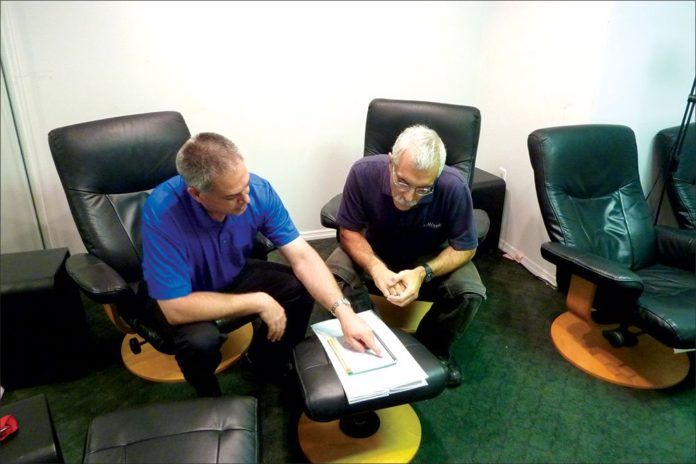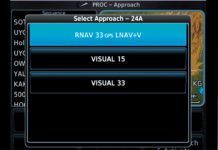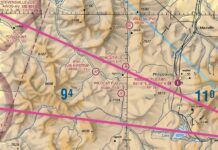The physical world is full of inverse proportions and one I’ve noticed is that when winter temperatures dip to, say, 20 degrees, my northern friends are four times more likely to bitterly complain that Florida, where I live, is nothing but a mosquito-infested fever swamp; God’s waiting room, if you will. But it’s something else, too: Florida is where instrument skills go to die.
And mine definitely had. And yet…instrument skills define the man…er person. Without them, you’re simply a poseur. This doesn’t exactly fit my idea of self-worth so in a moment of sheer lunacy, I scheduled myself for an instrument proficiency check last month.
In addition to self-flagellation, there was a larger purpose here: to find out how much my skills had eroded and what it would take to restore them. In the interests of pseudo-scientific inquiry, I decided on not just one IPC, but two—one in the airplane, one in a Redbird simulator. How would the two compare and what would they cost?
Beyond Rust
I have a lot of instrument time. Something like a third or more of my total time is actual instrument chiefly because I instructed intensively in the northeast during a period in which I also edited IFR for almost 10 years. An IFR Jedi was I. But yesterday’s Jedi is today’s doughy pilot-lounge wannabe. The skills—the basic scan, the mental bandwidth management, the judgment and interpretation—that are IFR flying are as perishable as snow in Florida.
Having administered dozens of IPCs myself—some back in the day when we called them ICCs—I’ve observed that there are two kinds of IFR incompetents: pilots who just lose the scan and can’t make the airplane dance and those whose scan is solid, but who lose it, in varying degrees, when it’s time to find a plate or locate the &^%$ timer on the GPS or any of the myriad other tasks related to instrument flying. I am definitely of the second type, aggravated by the fact that I am neither patient, tolerant nor a nice person.
My last legal currency granted via the synthetic experience of an IPC was almost five years ago. I suspected my scan would be solid—it was—but I’d have trouble with the finer points. I did.
Deer in the Landing Lights
My first oh-crap moment was quick in coming. For the oral portion of my IPC, instructor Robert Beer sketched on the whiteboard a VOR quadrant, with indicators showing various needle positions. Where, he queried, was the aircraft located relative to the VOR in each one and what were the required headings to intercept specified radials? In the age of GPS, I hadn’t done this for years; the wheels were turning, but the lips weren’t moving.
Then I realized I had just finished a private pilot rating with a student less than a year ago and I’d taught him this. With the problem placed into that context, the answers—correct ones—were forthcoming, suggesting the disquieting notion that I could teach it without knowing it. Either that, or some distorted reptilian age-related factor crept in, but I couldn’t know this because I’ve never been this old.
What always sent me off in giving IPCs was that pilots showed up expecting to be taught. But IPC means Instrument Proficiency Check, and while we each should learn from every experience, this one is not supposed to be primarily about learning. Accordingly, I swept through the FAR/AIM to refresh myself on what I thought I knew. When Beer asked about the FAR 91.175 landing requirements, I was all over it. I was less impressive in citing the lost comm requirements. Let’s see, does ADEF apply to route or altitude and what the heck did ACE mean?
At some point in this quizzing, Beer thought he’d seen signs of intelligent life, so we progressed to the next step: the airplane, a not-that-old Cessna 172R. Droning through the airwork, I recalled what I like about the 172: it’s an excellent instrument airplane; stable as a box of rocks and not trim hungry. Despite five years of atrophy, I nailed headings, rate climbs and descents and it was, well, fun. As I expected, my scan was good as ever. Even partial panel was easy, although I’d like to know what genius at Cessna specified a magnetic compass whose card lives at the back of a dark cave of a case and isn’t readable even in bright sunlight.
On to the ILS at Sarasota. Despite a too-tight vector, I nailed this one, too. It felt like the airplane was on rails and could fly itself. And when I loosed the yoke to fuss with my iPad, it did, without moving so much as a half dot. Could it get any better that this?
No, but it could—and did—get worse. Setting up for a VOR approach to SRQ, I got the same lousy turn on, followed by a bad start and a worse finish. While I was struggling to avoid busting the intermediate altitude, I was desperately recalling something about course narrowing with on-airport VORs. When the needle slammed off-scale with an audible thump, it all came rushing back. The diplomatic Mr. Beers suggested a re-do of that apocalyptically mucked up approach and the second attempt proved serviceable, if not as pretty as the ILS.
Beers told me I looked relaxed and comfortable, but I didn’t feel that way. I was working hard not so much on basic aircraft control, but in adding radio and related headwork to the basic scan. I was sweat-dampened when we landed and almost dysfunctionally fatigued. Bottom line: $380 for not quite two hours of aircraft time and instruction. IPC complete; currency restored.
Into the Box
I have a love-hate relationship with simulators. Twenty years ago, I used a Link—yeah, the one that looks like a little single-seat airplane—to instruct instrument students and I loved the thing. A terrific teaching tool, it produced better results quicker and cheaper. Modern sims like Frasca, Diamond and Redbird, among others, go that Link many times better, but I still don’t much like flying them myself. I recognize the training potency, but sans the prospect of instant death or the opportunity to spew CO2 for no good reason, the magic just isn’t there for me in a sim as it is in an airplane.
Nonetheless, in the name of further research, I booked an IPC at Cirrus Aviation in Sarasota, which has a Redbird FMX motion simulator configured as a G1000 Cessna 172. I’d flown these before and recently, but not on the gauges. One appeal of the sim is that you just, well, get in it. No tedious preflight or weather briefing, no yammering on the radio to get to the runway. Walk in the flight school door and you’re flying three minutes later.
Instructor Richard Sprague ran me through some basic air work similar to what I’d done with Beer, but on the way to the first approach fix. While en route, we did the standard partial panel drills, which you really can’t duplicate in a G1000 airplane but you can do in the sim.
With a failed AHRS, the red Xs slash out the PFD and you revert to the standby gauges to the left of the PFD. In the Redbird, these gauges look like paste-on decals and you’d swear they’re not going to move. But they do and really rather smoothly. Redbird’s version of Cessna’s compass genius is to put it on the far right of the panel, just to make the scan more challenging. At least it’s illuminated and easy to read.
Despite being fresh from a real-airplane IPC, my air work in the Redbird was anything but pretty. Even when I thought I had it carefully trimmed, I’d get variable pitch and roll feedback and resultant excursions. Sprague pointed out—and I noticed—random thumps and wiggles from the sim, even though he hadn’t turned on any turbulence. This is, of course, partly due to the fact that sims don’t get the flight dynamics just right. They’re close, but not exact. Sprague compared it to swinging two bats in the box, but stepping up to the plate with just one. In other words, if you can fly the sim well, you’ll be great in the airplane. I’ve always thought that this is like saying if you feel good now, you’ll be even more terrific when you stop bashing your head with that ball peen hammer.
As for the glass versus the steam gauges, I frankly don’t notice the difference. I am happy with either. The real challenge of the glass scan for a steam-gauge guy is the systemic and powerful distraction of operating the navigation and communication. I’m rarely more than half current on the G1000, but its demands for attention will wreck your bandwidth and it did mine. Combined with massaging the sim’s flight dynamics, that distraction turned my ILS into a sword flight…or whatever the EFIS equivalent of that is. It was adequate, but not great. A non-precision RNAV approach was better, but hardly stellar. I discovered one thing interesting: in a G1000, I hardly scan the MFD at all, but revert to the nav data repeater on the PFD side, which probably confirms that this curmudgeon is hopelessly old school.
Despite my overall poorer performance in the sim, it’s more relaxed and has higher training value because you can stop it, reposition it, change the weather, review what you’ve just done and so on. That’s always been true and it’s more true now, given greater sim capabilities.
At the end of the session—total cost $153.50—instructor Sprague was ready to sign me off for an IPC, but I’d have wanted another 30 minutes at least to nail down some issues with G1000 and show a better ILS or two. Call it about $225 against the real airplane’s $380.
Revelations
A few closing notes are in order. Despite its lack of precise fidelity with the G1000—the knobs and keys look and feel different, for instance—the Redbird FMX is a superb G1000 trainer. It’s inexpensive enough ($85 per hour) to fly while you learn the system and that’s not true of the airplane. The knobs could stand some turning resistance; they’re so friction free that you tend to overshoot the desired setting.
And couldn’t they put some lights in this thing? I was using both paper approach plates and an iPad, but the light was too low to read the paper.
And that led to the final revelation: plate management on a tablet is vastly superior to paper in every way. The plates are easier to find and index and pinch zooming allows a level of customization that radically improves readability. Personally, I’ll never use paper again.
The airplane vs. sim IPC reminds me of Mr. Spoltare, an algebra teacher I had in high school. I hated the man and hated the unpleasant experience of being in his class. But learn algebra I did, and well. So if I decide to maintain instrument currency, I’ll suck it up and ride the box for an hour or two. It’s too good a value to do otherwise. But I’m not holding my breath that I’ll learn to like it.
When Paul Bertorelli was editor of IFR, glass was something you found in the kitchen…or the bar. As Editorial Director of Belvoir Media’s aviation group, he wishes he flew more.





